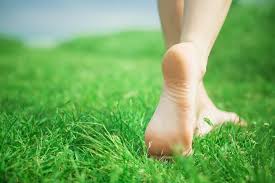
I hate walking barefoot. Unless I’m walking on a beach devoid of litter.
The thought of having dirty feet (worse if it also stinks) simply puts me off. I cannot understand why some of my colleagues love to remove their shoes in the office and walk around barefoot on the filthy carpet!
As children, my brothers would run in the garden barefoot, but I would refuse to step out unless I had shoes on.
My university mates used to poke fun at me because I’d be washing my feet before putting on socks and shoes, and after every dance class that didn’t require footwear.
Call it what you will, but it’s just one of my idiosyncrasies.
But I DO know that walking barefoot, especially on grass, is good for you. I just haven’t gotten around to doing it yet.
Modern living and the invention of footwear with insulating rubber- or plastic-soled shoes, instead of the traditional leather fashioned from hides, has resulted in us losing our connection with nature.
Lately though, more people are spending time walking barefoot on the grass in a method known as earthing or grounding. I’ve been noticing this in parks that I frequent.
This method, probably practised by our forefathers, refers to contact with the earth’s surface electrons by walking barefoot outside.
It can also refer to sitting, working or sleeping indoors, connected to conductive systems – some of them patented – that transfer the energy from the ground into the body.
Apparently, by having direct contact with the soil, our bodies are able to absorb negative electrons through the earth, which has its own natural charge.
It helps stabilise our daily cortisol rhythm and create a balanced internal bioelectrical environment.
Emerging scientific research supports the concept that the earth’s electrons induce multiple physiological changes of clinical significance, including reduced pain, better sleep, a shift from sympathetic to parasympathetic tone in the autonomic nervous system, and a blood-thinning effect.
The research, along with many anecdotal reports, is revealed by Clinton Ober in his 2010 book called Earthing.
Ober, a retired cable television executive, conducted some experiments and found a similarity between the human body (a bioelectrical, signal-transmitting organism) and the cable used to transmit cable television signals.
When cables are “grounded” to the earth, interference is virtually eliminated from the signal. We know that all electrical systems are stabilised by grounding them to the earth.
At the same time, two Polish researchers also carried out studies and discovered that grounding the human body represents a “universal regulating factor in nature” that strongly influences bioelectrical, bioenergetic and biochemical processes, and appears to offer a significant modulating effect on chronic illnesses.
In a 2012 study published in the Journal of Environment and Public Health, the authors write, “There is a possibility about the earth’s surface electrons as an untapped health resource – the earth as a ‘global treatment table’.
“Emerging evidence shows that contact with the earth – whether being outside barefoot or indoors connected to grounded conductive systems, may be a simple, natural, and yet profoundly effective environmental strategy against chronic stress, inflammation, pain, poor sleep, hypercoagulable blood, and many common health disorders, including cardiovascular disease.”
Another investigation, published in The Journal of Alternative and Complementary Medicine, found that earthing increases the surface charge of red blood cells. As a result, the cells avoid clumping, which decreases blood viscosity.
High viscosity is a significant factor in heart disease, which is why so many people take blood-thinning drugs daily to improve their heart health.
If you recall, just last month, Indian prime minister Narendra Modi shared a video about his morning fitness regime.
A yoga enthusiast, he gave a glimpse of his customised circular, walking track consisting of the five elements of nature.
He walks barefoot on gravel, and then moves on to walk on wet soil, a pool of shallow water, then sand. He concludes by walking on patches of lush green grass.
Modi, 67, attributes daily barefoot walking and yoga to his good health.
Walking also aids in physical and emotional rhythms. Unlike high impact running, walking is gentle, nourishing, gives us space, and yes, is preferred by the older generation.
As we walk, our breathing starts to synchronise with our motion, leading to a sense of expansion and freedom. By doing so barefoot, the benefits are increased. And it’s free!
Ideally, we should spend at least 15 minutes a day grounded, whatever time of the day. Just be careful of what’s on the ground that you’re walking on.
So today, I’m going to attempt walking barefoot in my garden. Of course, I’ll be scrubbing my foot hard with an antiseptic wash afterwards, but it’ll be worth it.
Revathi Murugappan is a certified fitness trainer who tries to battle gravity and continues to dance to express herself artistically and nourish her soul. The information provided is for educational and communication purposes only and it should not be construed as personal medical advice. Information published in this article is not intended to replace, supplant or augment a consultation with a health professional regarding the reader’s own medical care. The Star disclaims all responsibility for any losses, damage to property or personal injury suffered directly or indirectly from reliance on such information.
Source:-The Star

Leave a Reply